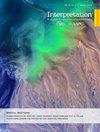盐丘和火山的断层样式对比:无监督学习技术能区分类似的断层样式吗?
IF 1.1
4区 地球科学
Q3 GEOCHEMISTRY & GEOPHYSICS
Interpretation-A Journal of Subsurface Characterization
Pub Date : 2022-11-10
DOI:10.1190/int-2022-0018.1
引用次数: 0
摘要
在地震数据中看到的一个吸引人的特征,也被称为有趣的东西或FLT,从此有了广泛的解释,从噪音模式到振幅异常。从机器学习(ML)算法的角度来看,FLT的一个例子是火山侵入和盐侵入之间的类似断层模式。通常,地震解释人员没有完整的数据集或地质背景来确定所观察到的特征的成因。当试图确定入侵是火山还是盐动起源时,这可能会特别令人困惑,因为它们表现出相似的地貌。我们研究了墨西哥湾的这些特征的差异,墨西哥湾是一个有充分记录的盐盆地,而新西兰的塔拉纳基盆地是火成岩易发的。该分析旨在根据地震数据和遥感工具共享的几何形状和属性来识别地质特征。地震属性和ML技术突出了入侵之间的异同。我们讨论了机器学习技术,如自组织地图(SOMs),一种无监督的机器学习技术,以及不考虑地质背景的聚类断层系统。SOM中使用的属性有断层概率、断层倾角方位、断层倾角大小和薄层探测器。故障概率是通过卷积神经网络故障预测和骨架化过程的结合来实现的。一旦使用SOM对断层进行聚类,就可以在考虑高断层概率(>75%)的情况下,对现有火山(火山或盐丘)造成的断层结构进行可视化。该方法包括从SOM网格中选择与故障存在相对应的神经元,并使用交叉图将其与故障概率和故障倾角相结合。交叉图积帮助自动提取故障平面,使用:(1)故障平面的体素表示和(2)表示故障平面的故障块。此外,所定义的可视化技术表明,交叉图乘积产生更好地定义断层面。在对断层系统进行表征后,我们利用相干性、断层倾角大小和方位角与具有相似属性的遥感图像进行比较。总之,我们的方法结合了各种技术,利用断层存在来区分侵入的成因——盐或火成岩,可以在前沿勘探或行星勘探中有所帮助。本文章由计算机程序翻译,如有差异,请以英文原文为准。
Contrasting faulting styles of salt domes and volcanos: Can unsupervised learning techniques differentiate similar fault styles?
An attractive feature seen on seismic data, also known as funny-looking thing or FLT, henceforth has a wide range of interpretations, from noise patterns to amplitude anomalies. An example of an FLT is the similar faulting patterns between a volcanic intrusion and a salt intrusion from the point of view of a machine learning (ML) algorithm. Oftentimes, seismic interpreters do not have a complete data set or geologic background to determine the genesis of the observed features. This can be particularly perplexing when trying to determine if an intrusion is volcanic or halokinetic in origin because they exhibit similar geomorphologies. We examine the differences in these features in the Gulf of Mexico, which is a well-documented salt basin, and the Taranaki Basin in New Zealand, which is igneous prone. The analysis aims to discern geologic features based on the geometries and attributes shared by seismic data and remote sensing tools. Seismic attributes and ML techniques highlight differences and similarities between the intrusions. We discuss ML techniques, such as self-organized maps (SOMs), an unsupervised ML technique, and cluster fault systems without regard to the geologic context. The attributes used in the SOM are fault probability, fault dip azimuth, fault dip magnitude, and thin-bed detector. Fault probability is performed through a combination of convolutional neural network fault prediction and a skeletonization process. Once the faults are clustered using SOM, the visualization of fault architecture due to the existing mount (either volcano or salt dome) is done considering high fault probabilities (>75%). The methodology consists of selecting the neurons from the SOM grid corresponding to the presence of faults and combining them with fault probability and a fault dip azimuth using a crossplot. The crossplot product assists in the automatic extraction of the fault planes using: (1) a voxel representation of the fault planes and (2) fault patches representing the fault planes. Moreover, the visualization technique defined demonstrates that the crossplot product yields better-defined fault planes. With the fault system characterized, we compare horizon slices using coherence, fault dip magnitude, and azimuth against remote sensing images with similar attributes. In conclusion, our methodology combines technologies to differentiate the genesis of intrusion — salt or igneous — using the fault presence and could be helpful in frontier exploration or planetary exploration.
求助全文
通过发布文献求助,成功后即可免费获取论文全文。
去求助
来源期刊

Interpretation-A Journal of Subsurface Characterization
GEOCHEMISTRY & GEOPHYSICS-
CiteScore
2.50
自引率
8.30%
发文量
126
期刊介绍:
***Jointly published by the American Association of Petroleum Geologists (AAPG) and the Society of Exploration Geophysicists (SEG)***
Interpretation is a new, peer-reviewed journal for advancing the practice of subsurface interpretation.
 求助内容:
求助内容: 应助结果提醒方式:
应助结果提醒方式:


